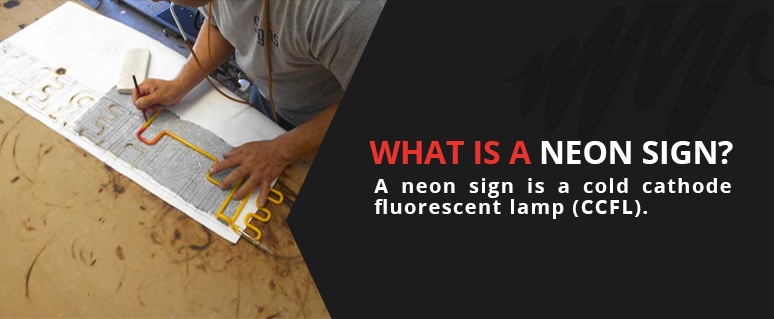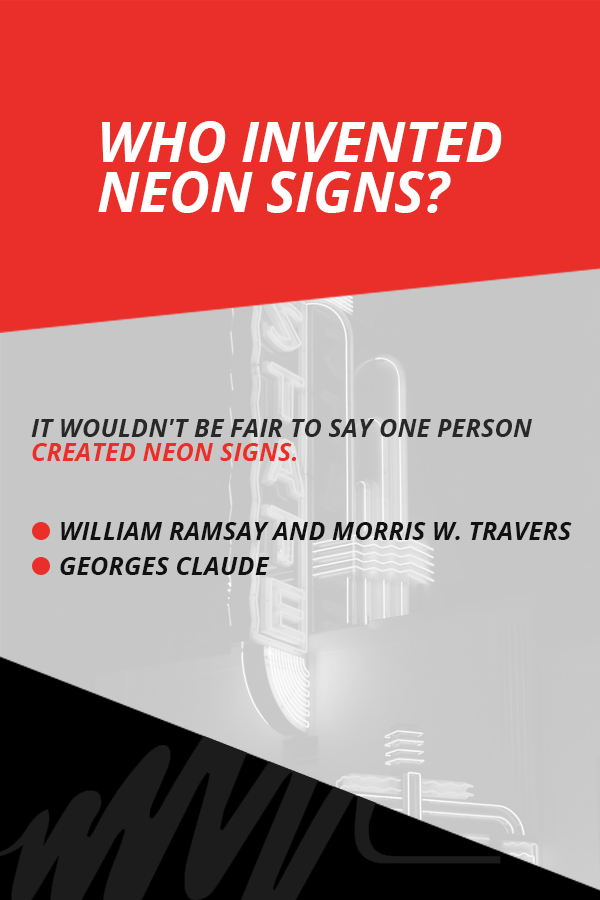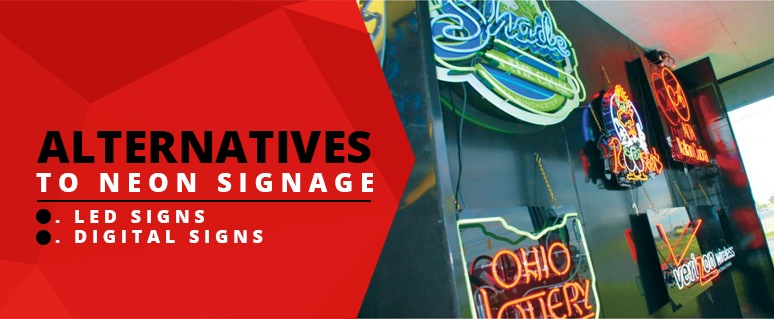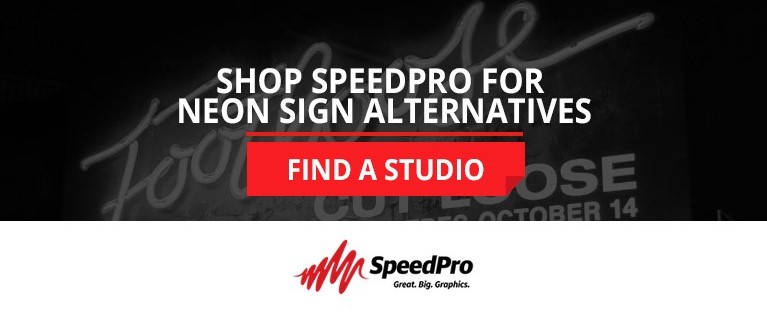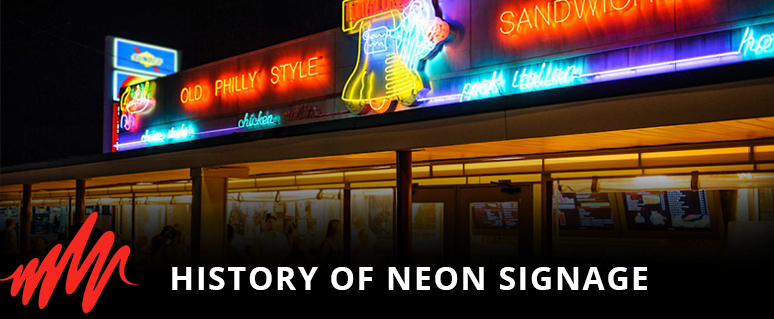
History of Neon Signage
MAY 13, 2019| SpeedProCategories
SignageWhen you think of a neon sign, what do you see? Do you envision a luminous flamingo pointing you to a tiki bar? Or do you recall the neon sign hanging in the window of your favorite diner? If you start to feel nostalgic when you dream up neon images, you’re not alone. Neon signs represent days gone by and cast a glow like no other light source.
In this post, we’ll explore the colorful history of neon signage, from its popularity in America to why they are fading into the past.
What Is a Neon Sign?
A neon sign is a cold cathode fluorescent lamp (CCFL). A typical neon sign is composed of glass tubes containing neon gas and a small amount of argon gas. Although neon is used to describe signs of different colors, neon does not produce every color. For example, a yellow “neon” sign is actually made with helium, not neon. Red neon signs, on the other hand, are created with neon gas. Neon signs are commonly used as accent lighting, to enhance building features or to draw attention to a product or service.
Who Invented Neon Signs?
It wouldn’t be fair to say one person created neon signs. Instead, neon signs gradually came into existence as the creation of several chemists and inventors over time. It took years of discovery and trial and error before neon signage set the night sky aglow. Here are the most notable contributors to the invention of neon signs.
1. William Ramsay and Morris W. Travers
In the 1800s, Scottish chemist William Ramsay and his colleague Morris W. Travers hunted the air for rare hidden gases. In 1898, Ramsay and Travers discovered neon along with krypton and xenon by isolating the gases from liquefied argon. Each of these gases emits a unique brilliant color when contained in a glass tube and charged with high voltage. Their discovery became the basis for neon lamps.
2. Georges Claude
Inventor Georges Claude also used techniques to liquify air and produced large amounts for industrial applications. He formed a company in 1902 called L’Air Liquide that quickly became a multinational corporation.
Claude conducted research while selling liquid oxygen in hope to make new discoveries. He found there was nothing left to pull from the air after Ramsay seemed to have found it all. He decided to focus on other matters like solving the problem of overly bright electrical lighting. He turned to neon, leftover from his liquefaction of air, to create alternative light sources.
Claude applied inventor Daniel McFarlan Moore’s concept of sending an electrical current through a gas-filled glass tube to create bright white light. Claude improved Moore’s invention by adding larger electrodes that stayed cooler longer and replacing the gases Moore used with neon. As a result, Claude’s neon lamps lasted for hundreds of hours and burned bright and steady.
In 1910, Claude filed a patent for neon lighting. Claude admitted that red neon was not a good choice for overall lighting but perfect to use in an attention-grabbing decorative light.
How Do Neon Signs Work?
A neon sign works because an electric current passes through the gas and makes it glow. On their own, gases are not good at conducting electricity. A gas, like neon, needs to be contained within a gas-discharge tube for a current to pass through. A gas-discharge tube is a glass tube sealed with electrodes. When a voltage is applied to the electrodes, the gas pressure reaches a level that enables an electric current to flow through the tube. The electric current sets the gas aglow. Neon emits red, while other gases produce different colors such as yellow and blue.
To make a neon sign, you need to learn difficult techniques taught by an experienced craftsman. The process involves using heat to bend glass tubes according to a pattern, attaching electrodes to the tube, pumping in gases and removing impurities from the glass. Overall it’s an involved process that requires practice and skill.
When Did Neon Signage Become Popular?
Georges Claude sparked the popularity of neon signs in 1912 when he installed the first neon advertising sign at a Parisian barbershop. Soon, other businesses, such as the Paris Opera, wanted the same eye-catching exteriors. To continue growing, Claude formed the company Claude Neon and sold franchises for neon signs. Dozens of franchises opened around the world.
The first American neon signs appeared in Los Angeles thanks to Earle C. Anthony, owner of a dealership for Packard Motor Car Company. Anthony had visited Paris and noticed Claude’s signs in 1923, and he had two custom signs made for his downtown showroom. The elegant orange neon signs read “Packard” and cost about half the price of a car. The signs were so captivating they reportedly caused traffic jams. In the 1920s, it was hard to drive by the Packard showroom without slowing down to view the hypnotic neon signs.
Soon, neon signs exploded in popularity in the United States, and they became a symbol of progress and modern industry. Neon signs were mainly designed to attract travelers who used interstate highway systems. As a traveler in the ’30s, you could expect to find neon signs promoting gas stations, motels and diners across the country. Also, bustling cities like New York, Los Angeles and Las Vegas became known for enticing customers to dine, dance, gamble, go to the movies and more with spectacular neon signs.
Neon’s popularity started to decline around World War II. Many business owners did not want to pay to repair malfunctioning signs and decided to replace neon signs with signs made of plastics and fluorescent tubes. Plastic signs were less expensive and easier to maintain than neon signs. Also, people began to associate neon signs with run-down motels, sleazy bars and other undesirable establishments. In the 1970s, there was a small neon sign revival which continues today. Modern neon signs are usually small and are often used to advertise beer or announce that a store is open.
Why Are Neon Signs Not Used Anymore?
Neon indoor signage can still be found in barrooms and homes across the country. However, many businesses have switched to other forms of illuminated signage for several different reasons such as:
- Neon signs are expensive.
- Elaborate custom neon signs require the work of experienced artisans.
- Neon signs break more easily than other types of sign materials and are harder to replace.
- Neon signs may not be reliable in cold weather because of the added argon.
- Neon signs are often heavier than other sign materials.
- Neon signs are less flexible than modern signs.
Even though neon signs are not as popular as they used to be, there’s still a deep appreciation for a neon glow. You can find neon signs displayed in museums dedicated to preserving their place in culture, and you can still find neon signs advertising businesses from nail salons to restaurants in many towns and cities.
Alternatives to Neon Signage
Neon signs emit a unique glow, unlike any other light source. However, they are very limiting when compared to modern signs. Here are a couple alternatives to neon signage and how they captivate onlookers and do far more than light up the sky.
1. LED Signs
Light-emitting diodes (LEDs) produce a mesmerizing glow similar to neon but offer higher efficiency and greater durability. LEDs are very small and usually mix red, green and blue to create white light. Many LED signs are lightweight compared to neon signs, and great for promoting sales, new products, events and more within a store, restaurant or other business. Some business owners install large LED signs outdoors to attract customers and relay messages. Unlike neon signs, you can change the advertisement on a programmable LED sign to suit your needs and reach customers however you wish. Here are a few more reasons businesses switch to LED signage:
- Energy-saving: LEDs emit light in a specific direction which decreases the need for light-trapping reflectors. They are one of the most energy-saving light sources available and use 75 percent less energy than incandescent lighting. By 2027, widespread use could equate to more than $30 billion savings in the U.S.
- Durable: LEDs are extremely durable and last 25 times longer than incandescent lighting, for example. With LEDs, you don’t have to worry about changing bulbs as often as other types of light sources, saving time and money. Neon signs, on the other hand, required skill and time to replace or repair parts.
- Emit little heat: LEDs do not emit a lot of heat unlike other lighting forms with may release up to 90 percent of their energy as heat.
- Reduced impact: LEDs do not contain mercury. Some neon signs, however, contain small amounts of mercury which can be hazardous to the environment. The Environmental Protection Agency (EPA) encourages households to contact local agencies about recycling a neon lamp rather than throwing it in the household trash.
- Reliable visibility: Because LEDs are easy to maintain and feature long lifespans, business owners don’t have to worry about their LED signs failing as often as other light sources, and they can rest assured their signs are always visible. LEDs also perform well in cold weather, unlike a neon sign which may take time to warm up.
- Bright and attractive: Some LED signs use movement or bold, brilliant colors to attract attention. Like neon signs, LED signs are hard to miss and can be a pleasure to view.
Business owners also have the option of creating advertisements using backlit graphics. Backlit graphics use LED light, frames and interchangeable fabric overlays featuring engaging custom designs and messages. They are also known as light boxes and can be used indoors, outdoors or wherever there is a power source. Backlit graphics offer an adaptable, lightweight solution for businesses who want to attract customers and stand out from a crowd.
2. Digital Signs
Digital signage gives business owners power like no other light source. A digital sign allows you to change the information being seen any time you want to update something, whether you want to project an attention-grabbing animated video, a calendar of events, new menu items or anything you can imagine. Also, digital signage holds a customer’s attention and feels familiar, similar to a TV. Overall, digital signage gives business owners complete control over the content they share. Here are a few more benefits:
- Enjoy flexibility: What could be more flexible than creating content on a computer and sending it to a sign? There’s no need to purchase a new sign every time you want to advertise a different product or service. You have endless possibilities with digital signage and can create animation and videos, share news, display photos and so much more.
- Get noticed: According to a Nielsen study from 2015, 75 percent of travelers noticed a digital billboard during the month before the survey, and 55 percent noticed the message on the screen most or all of the time. In other words, digital signage stands out and makes an impression.
- Inform and excite: According to the same survey, 61 percent of respondents agree digital billboards are a good way to learn about sales and events. This suggests that digital signage is an effective way to promote a business.
- Improve brand recall: Eight-two percent of survey respondents recalled advertising on digital billboards. If you want people to remember your brand, go digital.
- Boost customer satisfaction: Digital signage provides countless opportunities to make customers happy. First, they make things more convenient. For example, bright menu boards give customers an easy-to-read way to explore menu options so they can make choices faster and easier. Illuminated menus also help attract outside customers. Digital signs can be programmed to change with the day, month or season, making the workday easier for staff as well.
- Make customers comfortable: Digital signs can be used in so many different locations, from medical waiting rooms to hotel lobbies. You can use digital signage to share health tips with patients as they wait, for example. Or, digital signage can be used to direct people in a large building. Digital signs can’t be missed and fit seamlessly in any setting.
- Make promotions stand out: Are you having a big sale? Did a new product hit the shelf? Generate excitement and encourage customers to buy with an attractive digital sign.
Shop SpeedPro for Neon Sign Alternatives
Give your business the attention it deserves with high-quality displays that steal the show. At SpeedPro, we are excited to transform your vision into a jaw-dropping sign, whether you want to entice customers with a striking backlit graphics display or advertise daily specials with adaptable digital signage. Our team will work with you to find a unique sign solution and stand out from competitors. If you’re ready to get noticed, stop by one of our studios today.

















